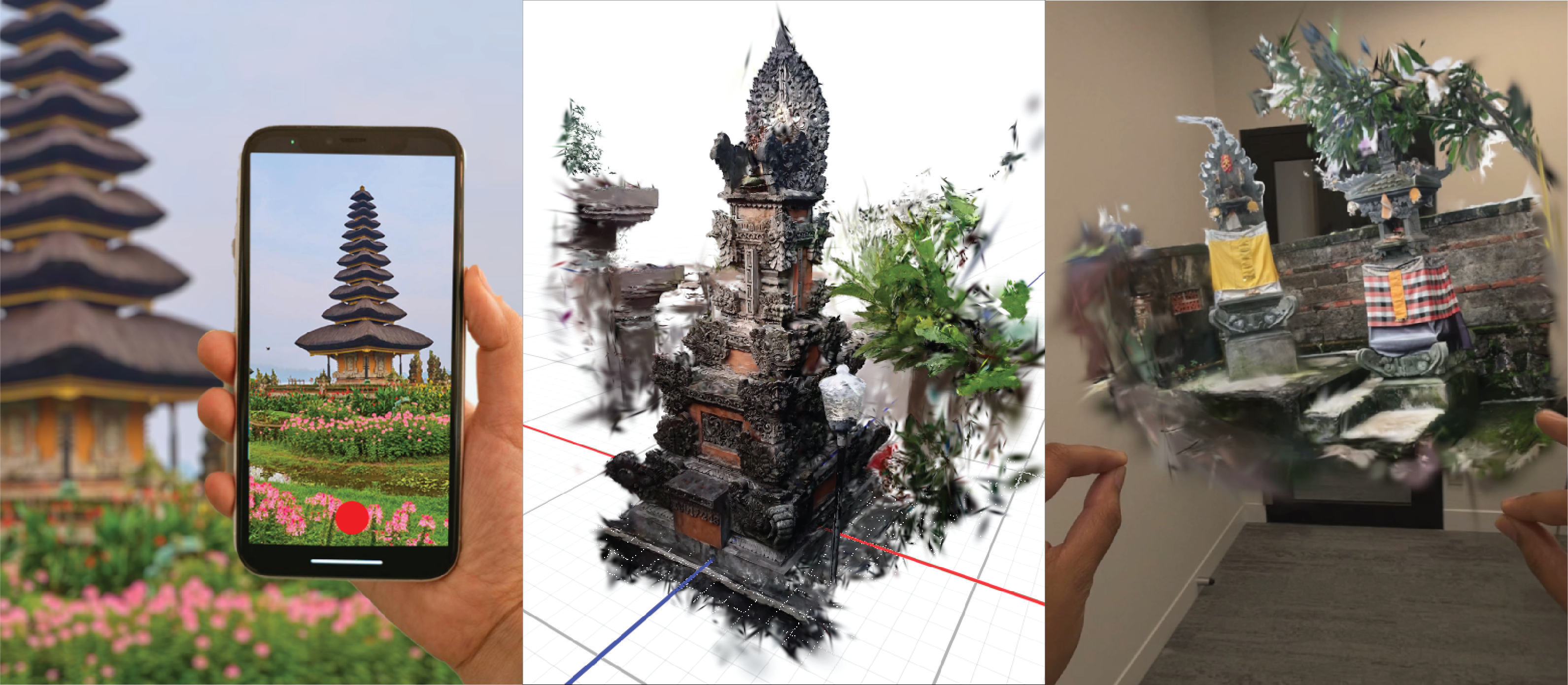Kadek Ananta Satriadi
Research domains: data visualisation, immersive analytics, VR/AR, storytelling, cultural heritage visualisation.
Recent Publications
-
Effects of Interface Layouts on Cognitive Performance for Pedicle Screw Placement Simulator in Immersive Environments
Lang Qin, Kadek Ananta Satriadi , Jiazhou Liu, Yuhan Zhan, Jiang Shao, Peimeng Liu, Zhiyong Chen, Yongtao Liu -
MM-WiMs: A Navigation Interface in ICH Multiscale Virtual Environments
Chenxin Zhang, Yong Hu, Kadek Satriadi, Xukun Shen -
3D Gaussian Splatting for Archival of Balinese Temples from Community-Sourced Videos
Anthony Wilson, Arnadi Murtiyoso, Bernhard Jenny, I Gede Mahendra Darmawiguna, Putu Hendra Suputra, Thomas Chandler, Made Windu Antara Kesiman, Kadek Ananta Satriadi
Featured Projects
Selected Publications

3D Gaussian Splatting for Archival of Balinese Temples from Community-Sourced Videos
We present a novel application of 3D Gaussian Splatting (3DGS) for the large-scale archival of thousands of temples in Bali. Our project, the Bali Digital Heritage Initiative, adopts a participatory approach in which local communities collect video footage of these vulnerable temples, which we transform into 3DGS scenes to serve as digital archives.
Keywords: 3D Gaussian Splatting, cultural heritage, crowdsourcing
Wilson, A., Murtiyoso, A., Jenny, B., Darmawiguna, I. G. M., Suputra, P. H., Chandler, T., Kesiman, M. W. A., & Satriadi, K. A. (2025). 3D Gaussian splatting for archival of Balinese temples from community-sourced videos. IEEE International Conference on Imaging Systems and Techniques, Strasbourg, France.
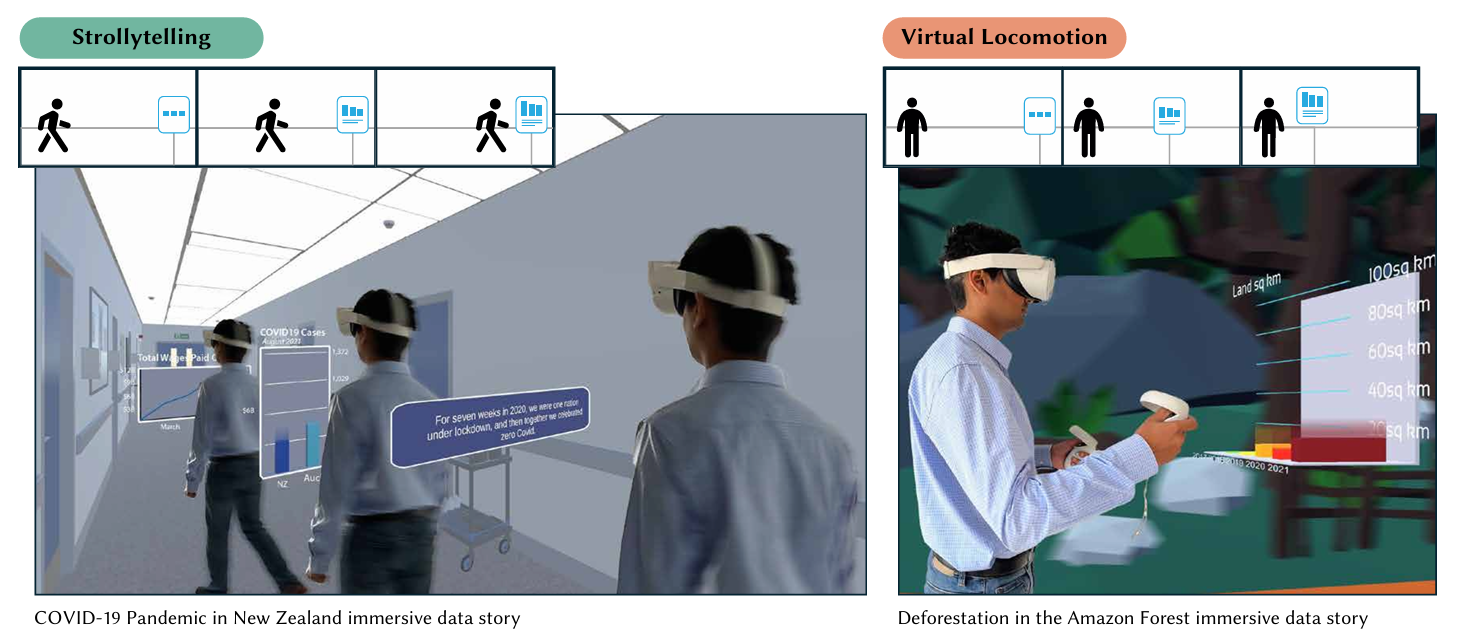
Strollytelling: Coupling Animation with Physical Locomotion to Explore Immersive Data Stories
We propose and explore 'strolly'telling, a novel data storytelling technique that maps the story progression with the user/audience’s physical locomotion. Inspired by the conventional web-based technique for scrolling-based stories (i.e. scrollytelling), our technique tightly couples the user’s position in physical space to the animation frame of the data story. This technique leverages the natural tendency of humans to 'walk and talk' while telling a story and requires users to engage with the content actively.
Keywords: chi,storytelling,immersive storytelling
Jain, R. P., Drogemuller, A., Satriadi, K. A., Smith, R., & Cunningham, A. (2025). Strollytelling: Coupling Animation with Physical Locomotion to Explore Immersive Data Stories. In Proceedings of the 2024 CHI Conference on Human Factors in Computing Systems (pp. 1-17)
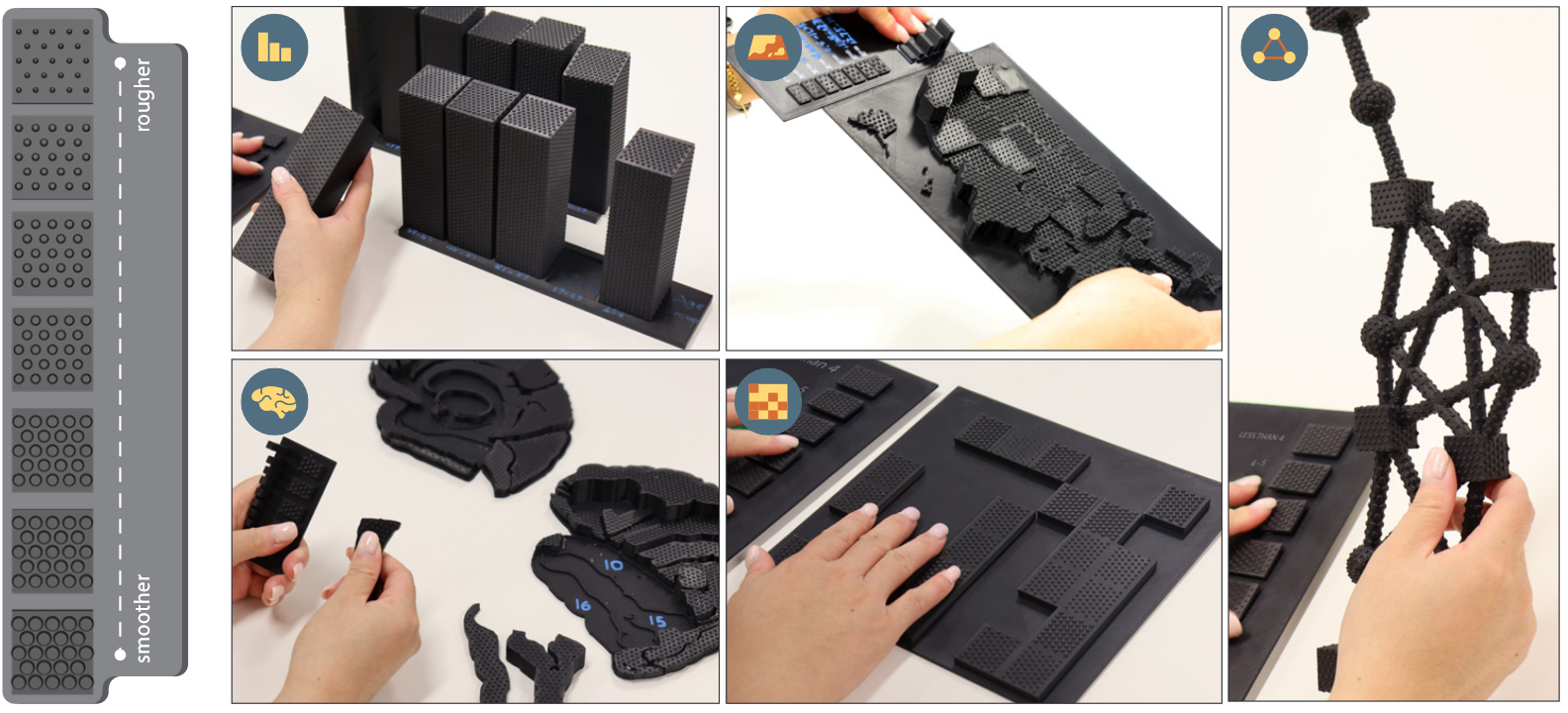
That's Rough! Encoding Data into Roughness for Physicalization
While visual channels (e.g., color, shape, size) have been explored for visualizing data in data physicalizations, there is a lack of understanding regarding how to encode data into physical material properties (e.g., roughness, hardness). This understanding is critical for ensuring data is correctly communicated and for potentially extending the channels and bandwidth available for encoding that data. We present a method to encode ordinal data into roughness, validated through user studies.
Keywords: chi,physicalization,visualization
Du, X., Satriadi, K. A., Drogemuller, A., Matthews, B. J., Smith, R., Walsh, J. A., & Cunningham, A. (2024, May). That's Rough! Encoding Data into Roughness for Physicalization. In Proceedings of the 2024 CHI Conference on Human Factors in Computing Systems (pp. 1-16).

Active Proxy Dashboard: Binding Physical Referents and Abstract Data Representations in Situated Visualization through Tangible Interaction
We introduce a conceptual design space defining four quadrants as combinations of two dimensions: spatial to abstract representation; and passive to active proxy. Our focus is the novel quadrant defined by active proxies and abstract representations. Designing active proxy techniques is non-trivial as users are accustomed to common interaction modalities.
Keywords: chi,dashboard,late-breaking work,scale model,situated visualization,tangible
Satriadi, K. A., Ens, B., Goodwin, S., & Dwyer, T. (2023, April). Active Proxy Dashboard: Binding Physical Referents and Abstract Data Representations in Situated Visualization through Tangible Interaction. In Extended Abstracts of the 2023 CHI Conference on Human Factors in Computing Systems (pp. 1-7).

Embodied Provenance for Immersive Sensemaking
We propose the concept of embodied provenance, the use of three-dimensional space and embodied interactions in supporting recalling, reproducing, annotating and sharing analysis history in immersive environments. We propose a conceptual framework for embodied provenance by highlighting a set of design criteria for analytic provenance drawn from prior work and identifying essential properties for embodied provenance.
Keywords: analytics provenance,embodied,iss
Zhang, Y., Ens, B., Satriadi, K. A., Yang, Y., & Goodwin, S. (2023, April). Embodied Provenance for Immersive Sensemaking. To be presented at ACM Interactive Surfaces and Spaces Conference.
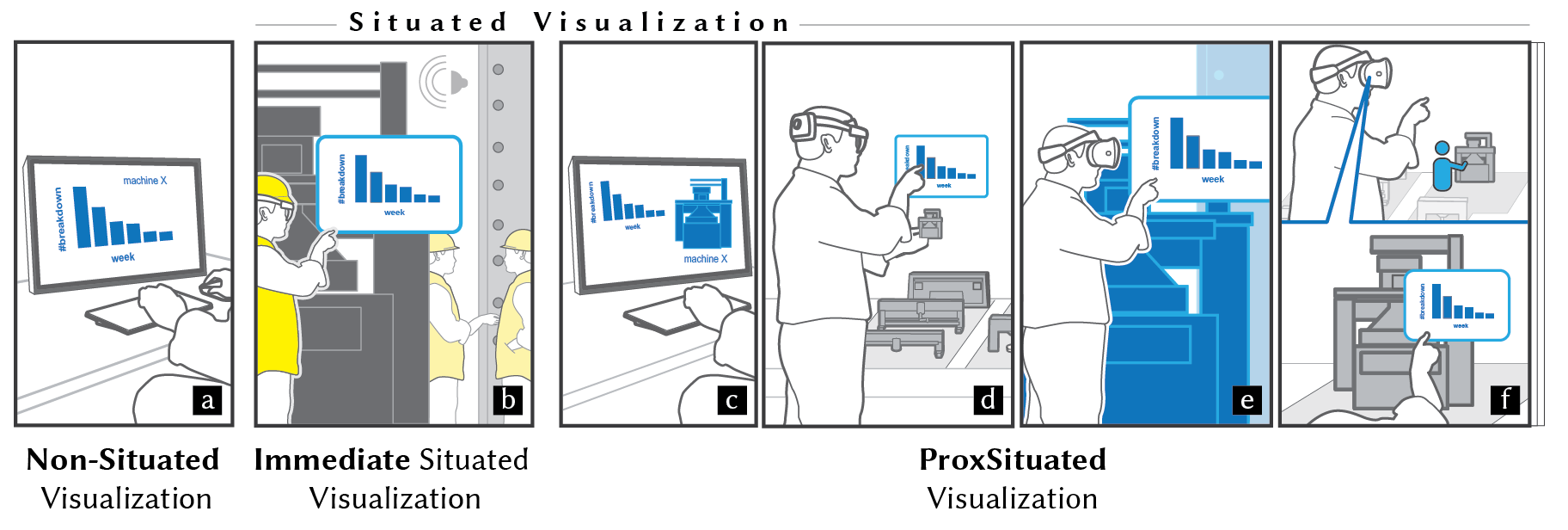
ProxSituated Visualization: An Extended Model of Situated Visualization using Proxies for Physical Referents
We propose an extended model of situated visualization that encompasses Immediate Situated Visualization and ProxSituated (Proxy of Situated) Visualization. Our model describes a set of key entities involved in proxSituated scenarios and important relationships between them. From this model, we derive design dimensions and apply them to existing situated visualization work.
Keywords: chi,design space,situated visualization,theory
Satriadi, K. A., Cunningham, A., Smith, R. T., Dwyer, T., Drogemuller, A., & Thomas, B. H. (2023, April). ProxSituated Visualization: An Extended Model of Situated Visualization using Proxies for Physical Referents. In Proceedings of the 2023 CHI Conference on Human Factors in Computing Systems (pp. 1-20)
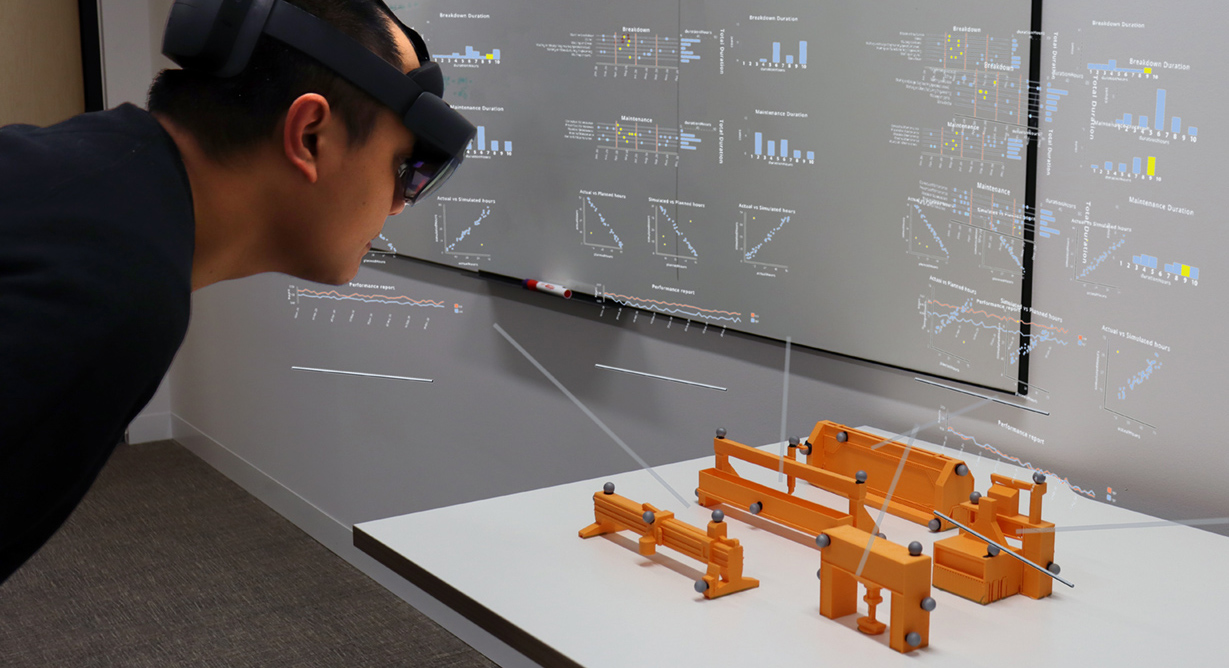
Augmented Scale Models: Presenting Multivariate Data Around Physical Scale Models in Augmented Reality
We present augmented scale models, immersive visualisations that place charts of multivariate data via Augmented Reality (AR) registered to physical 3D models. We identified two main factors for presenting AR charts in the limited display space around the models: 1) how charts are laid out (Slides vs Dashboard), and 2) how the chart views are arranged in the 3D space (On Scale Model, On Table, On Virtual Board).
Keywords: augmented reality,dashboard,ismar,layout,scale model,situated visualization,tangible
Satriadi, K.A, Cunningham, A., Thomas, B.H., Drogemuller, A., Odi, A., Patel, N., Aston, C., & Smith, R.T. 2022. Augmented Scale Models: Presenting Multivariate Data Around Physical Scale Models in Augmented Reality. In IEEE International Symposium on Mixed and Augmented Reality, Oct 17 - 21 2022, Singapore.
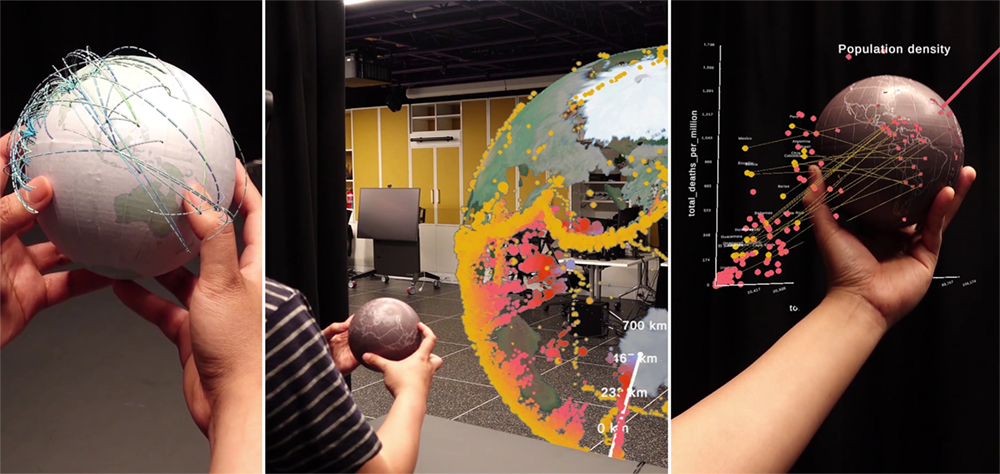
Tangible Globes for Data Visualisation in Augmented Reality
We explore the design space and use cases of tangible globe visualisation in AR. We created custom tangible globes that can be tracked in 3D space using a combination of a motion capture system and HoloLens 2. The globe has internal infrared LEDs, as opposed to standard marker-based motion tracking. This allows for a clean view of geographical information on the globe surface.
Keywords: augmented reality,chi,design space,geovisualisation,globe,tangible
Satriadi, K.A., Smiley, J., Ens, B., Cordeil, M., Czauderna, T., Lee, B., Yang, Y., Dwyer, T., Jenny, B. 2021. Tangible Globes for Data Visualisation in Augmented Reality. In CHI ’22: ACM Conference on Human Factors in Computing Systems, April 30 - May 5 2022, New Orleans, USA. doi:10.1145/3491102.3517715
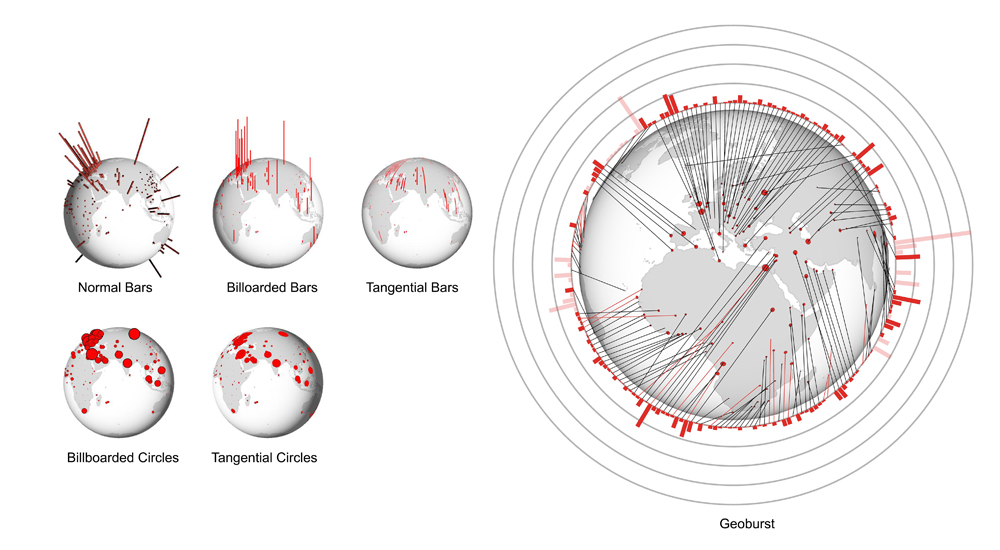
Quantitative Data Visualisation on Virtual Globes
We evaluated five different globe visualisation idioms and then proposed a new visualisation design. Geographic data visualisation on virtual globes is intuitive and widespread, but has not been thoroughly investigated. We explore two main design factors for quantitative data visualisation on virtual globes: i) commonly used primitives (2D bar, 3D bar, circle) and ii) the orientation of these primitives (tangential, normal, billboarded).
Keywords: chi,globe,perception,virtual globe
Satriadi, K. A., Ens, B., Czauderna, T., Cordeil, M., Jenny, B. 2021. Quantitative Data Visualisation on Virtual Globes. In CHI ’21: ACM Conference on Human Factors in Computing Systems, May 08–13, 2021, Yokohama, Japan. doi:10.1145/3411764.3445152

Maps Around Me: 3D Multiview Layouts in Immersive Spaces
We conducted a user study to obtain a better understanding of how users arrange immersive multiview maps. Visual exploration of maps often requires a contextual understanding at multiple scales and locations. Multiview map layouts, which present a hierarchy of multiple views to reveal detail at various scales and locations, have been shown to support better performance than traditional single-view exploration on desktop displays.
Keywords: geovisualisation,iss,layout,maps,virtual reality
Satriadi, K. A., Ens, B., Cordeil, M., Czauderna, T., Jenny, B. (2020, November). Maps Around Me: 3D Multiview Layouts in Immersive Spaces. In Proc. ACM Hum.-Comput. Interact. 4, ISS, Article 201 (November 2020), 20 pages. doi:10.1145/3427329

Augmented Reality Map Navigation with Freehand Gestures
We evaluated freehand gestures design space for AR map navigation. Mid-air hand gesture interaction has long been proposed as a ‘natural’ input method for Augmented Reality (AR) applications, yet has been little explored for intensive applications like multiscale navigation. In multiscale navigation, such as digital map navigation, pan and zoom are the predominant interactions.
Keywords: augmented reality,gesture,ieeevr,maps
Satriadi, K. A., Ens, B., Cordeil, M., Czauderna T. , Willett, W., Jenny, B. (2019, March). Augmented reality map navigation with freehand gestures. In 2019 IEEE Conference on Virtual Reality and 3D User Interfaces (VR) (pp. 593-603). IEEE. doi:10.1109/VR.2019.8798340
List of all Publications


